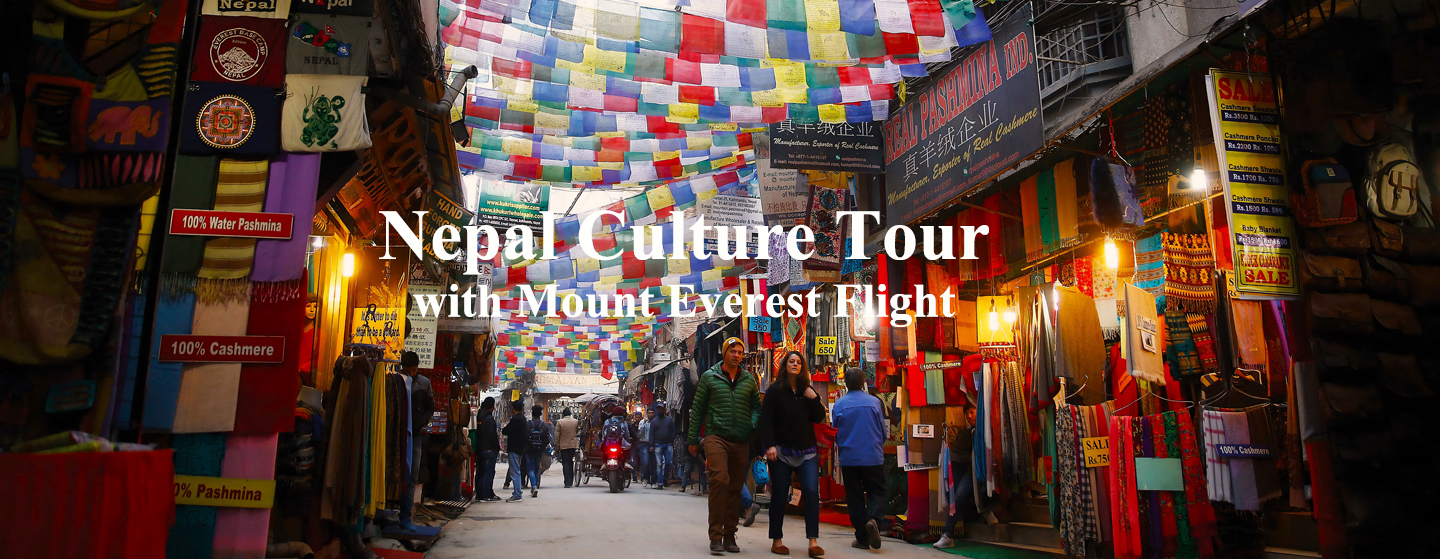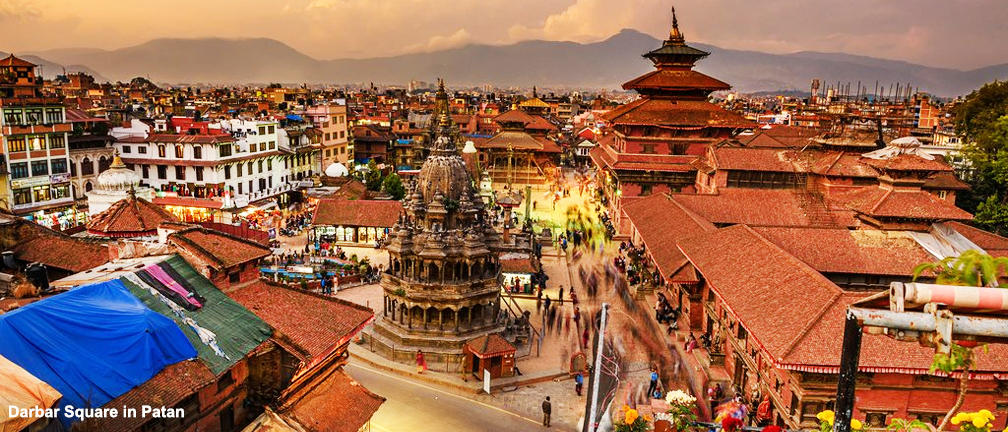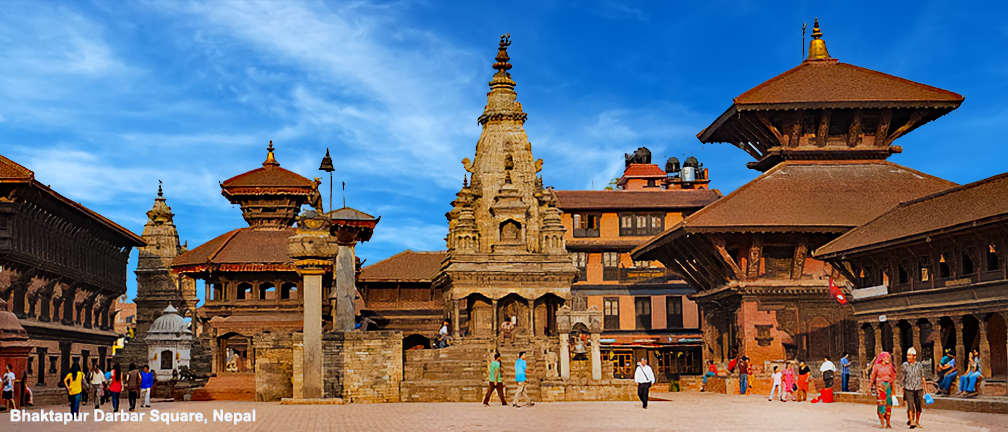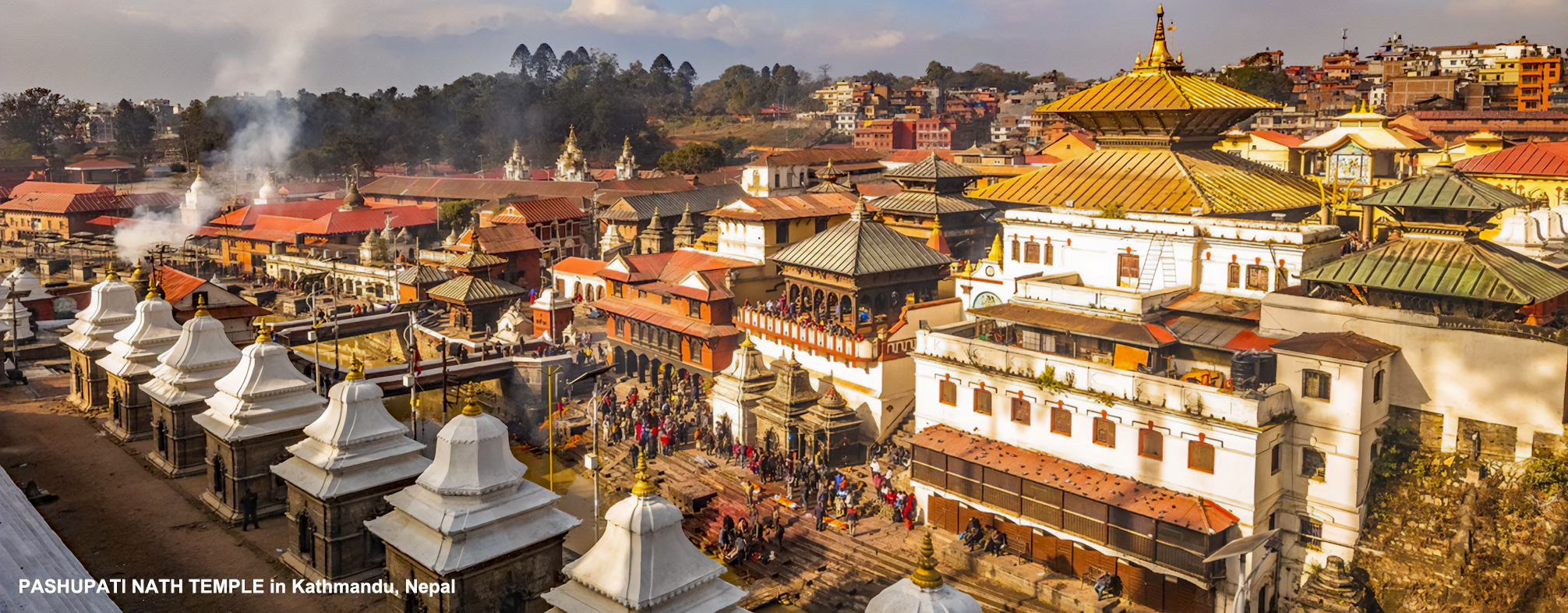Nepal Culture Private Tour With Mount Everest Flight

Relish the blend of Hindu and Buddhist culture and architecture in this ancient Himalayan city. The proposed itinerary is designed as an optional extension tour of cultural Nepal but we would be glad to expand it to include other destinations of interest in Nepal to custom design your own private Nepal tour.
In 1768 Kathmandu was conquered and the foundation of a unified kingdom was laid by the Gorkha ruler, Prithvi Nath Shah. In 1792 further expansion was halted because of defeat by Chinese in Tibet. The Anglo-Nepalese War of 1814 to 1816 resulted in present boundaries. In 1846 Nepal fell under influence of heredetary Rana Chief Ministers who controlled the Monarchy and cut the country from outside world. The treaty of 1923 with British re-affermed Nepal's Sovereignity. In 1950 the anti-Rana forces based in India allied with the Monarch.
In 1951, the Nepal King Tribhuvan Bir Bikram Shah II, ended the century-old system of rule by hereditary premiers and instituted a cabinet system of government. The anti-Rana forces under the Nepalese Congress form the government. In 1953 the New Zealander Edmond Hillary with Nepal's Sherpa Tenzing Norgay became the first to climb Mount Everest. Nepal joined the United Nations in 1955.
King Tribhuvan passed away in 1955 and King Mahendra accended the Throne. In 1959 multi-party constitution was adopted. King Mahendra seized control and suspends parliament, constitution and party politics after Nepali Congress Party (NCP) wins elections with B. P. Koirala as premier in 1960. New constitution provides for non-party system of councils known as "Panchayat" under which king exercised sole power. First elections to Rastrya Panchayat held in 1963. In 1972 King Mahendra passed away and King Birendra succeeded him.
Reforms in 1990 established a multiparty democracy within the framework of a constitutional monarchy. Birendra Bir Bikram Shah who was born on December 28, 1945, ascended the throne of Nepal on January 31, 1972. He was a very popular monarch. On June 1, 2001 his son, Dipendra Bir Bikram Shah, shot and killed the entire royal family and wounded himself also. Four days later Prince Dipendra passed away. King Birendra's younger brother, Gyanendra Bir Bikram Shah ascended the throne on June 4, 2001. He was not very popular in Nepal although he re-introduced democracy in the country by declaring elections to the nation's parliament.
An insurgency led by Maoists broke out in 1996. The ensuing 10-year civil war between Maoist and government forces witnessed the dissolution of the cabinet and parliament and assumption of absolute power by the king in 2002. Several weeks of mass protests in April 2006 were followed by several months of peace negotiations between the Maoists and government officials, and culminated in a late 2006 peace accord and the promulgation of an interim constitution. Following a nationwide election in April 2008, the newly formed Constituent Assembly (CA) declared Nepal a federal democratic republic and abolished the monarchy at its first meeting the following month. The CA elected the country's first president in July. Between 2008 and 2011 there were four different coalition governments, led twice by the United Communist Party of Nepal-Maoist, which received a plurality of votes in the 2008 CA election, and twice by the Communist Party of Nepal-United Marxist-Leninist (UML). After the CA failed to draft a constitution by the May 2012 deadline set by the Supreme Court, then Prime Minister Baburam BHATTARAI dissolved the CA. Months of negotiations ensued until March 2013 when the major political parties agreed to create an interim government headed by then Chief Justice Khil Raj REGMI with a mandate to hold elections for a new CA. Elections were held in November 2013, in which and the Nepali Congress won the largest share of the seats in the CA and in February 2014 formed a coalition government with the second place UML and with Nepali Congress President Sushil KOIRALA as Prime Minister.
In April 2015 a 7.8 magnitude earthquake struck Kathmandu and surrounding areas causing death of about 8,000 persons and causing massive destruction including many Unesco World Heritage Monuments and Sites.
In September 2015 a new secular constitution is formed. In October 2015 K. P. Prasad became 1st. Prime Minister under the new constitution. In July 2016 the Maoists pulled out of the government and Prime Minister K. P. Olir esigned ahead of a no-confidence vote in Parliament. In August 2016 the parliament elected the communist leader Pushpa Kamal Dahal a.k.a Prachanda, as Prime Minister. In 2016 Sher Bahadur Deuba takes over as Prime Minister under a rotation system and is set to remain in his position until 2018.
Like in all countries around the world Nepal also suffered under Covid19 pandemic in 2021. 2022 is the year of national elections in Nepal.
Despite political upheavals mountaineering, cultural and wildlife tours of Nepal have been very popular with foreign tourists and are not only a very important source of foreign currency but tourism also provides employment to a Substantial part of the Himalayan country.
ITINERARY :
Day 1: Delhi :
Arrival in Delhi and transfer to hotel in Gurgaon or New Delhi near Airport. for overnight.
Day 2: Kathmandu :
After breakfast, transfer to Indira Gandhi International Airport to board the flight to arrive in Kathmandu in early afternoon, transfer to hotel. After check in sightseeing tours.

Boudha Nath Temple - the world’s largest stupa. a sight of great veneration to the Buddhists, is a colossal stupa north east of Pashupatinath. The origin of this stupa is rather obscure. A legend says that a woman named Kangma was banished from heaven by Indra for stealing flowers and was reborn on earth as a swineherd’s daughter. Rearing and selling geese, Kangma accumulated a considerable amount of wealth. One day, she went to request the king for a plot of land to build a temple dedicated to the Buddha Amitabha. She asked that she be given land the size which a buffalo’s hide would cover. The king agreed to what he thought was a harmless request, but Kangma very shrewdly cut the hide making it into one very long strip of leather. Stretching it out to form a very large circle. She asked for and was given this huge plot where Boudhanath stands today.
If time does not permit after check in we arrange visit to THAMEL which is touristy place. In this case we will include above place in other days. Overnight in hotel in Kathmandu.

Day 3: Full Day tour of Patan & Bhaktapur-Nagarkot :
Sightseeing tour of the Patan - a city of heritage wooden architecture and fine arts. Visit Tibetan Handicraft center at Jawalakhel to watch carpet weaving. Patan Durbar Square complex, situated in the center of Patan city, also known as Lalitpur, houses the residence of the former Patan royal family. Patan Square and its surroundings are good specimen of ancient Newari architecture. There are three main courtyards in the palace: Mul Chowk, Sundari Chowk and Keshav Narayan Chowk. Mul Chowk, the oldest one, is at the centre of Patan square. Several multi- sized and multi-styled temples occupy the western part of the complex. Main among these are Krishna Temple, Bhimsen Temple and the Golden Temple of Hiranya Varna.

Bhaktapur city- Kathmandu valley's most medieval city also known as Bhadgaon and was one of the three Kingdoms of Mallas. It is famous for Lion gate, the picture gallery, the Golden gate and palace of 55 windows. Lunch break in Bhaktapur before sightseeing and finally transfer to Nagarkot for sunset view.

Nagarkot is situated 32 km east of Kathmandu at an altitude of 2175 meters above sea level. Nagarkot is a popular tourist spot of Nepal. The panorama of the major peaks of eastern Nepal Himalayas including Sagarmatha (Mt. Everest-if weather permits), can be seen from here). The Himalayan peaks Like Manaslu (8463 meters). Ganesh Hinial (7111 meters), Langtang(7246 meters), Choba Bhanre (60l6 meters), and Gaurishanker (7134 meters) are all visible from Nagarkot in clear sky). Overnight at hotel in Nagarkot.
Day 4: Nagarkot - Kathmandu - Sightseeing ( 9 Am to 5 Pm) :
In the morning enjoy the amazing views of Himalayan Mountains at sunrise. After breakfast drive to Kathmandu. After check in sightseeing tours:

Sightseeing of Pashupatinath Temple - the most sacred of the Hindu temples in Nepal dedicaed to lord Shiva, first established in 5th century. The holiest Hindu pilgrimage place in Nepal Pashupati has received the attention of worshippers for at least fifteen hundred years. Dedicated to Shiva, the temple is situated on the banks of the Bagmati river. A circuit of the Pashupati area takes visitors past a sixth century statue of the Buddha an eighth century statue of Brahma the Creator freshly painted skeletal images guarding temple gates, and other magnificent temples dedicates to various deities in the complex.
Swayambhunath temple - the oldest Buddhist shrine. Looking east from here, one can see the entire Kathmandu valley spread out below. and lunch break in Kathmandu durbar square. Swayambhunath is a best place to observe religious harmony between Nepalese Buddhists and Hindus. The stupa is one of the most ancient in this part of the world and its worshippers come from diverse ethical backgrounds. Situated on the top of a hill, it provides an excellent view of the Kathmandu Valley. Huge prayer wheels and fine Buddhist paintings are displayed in the monasteries as well as the largest Buddha statue in the country. Special butter lamps can be lit after monetary gifts are offered to the images.
Kathmandu Durbar Square– the temple of the Living Goddess and the old Royal Palace. Finally, visit Kasthamandup – a temple built from a single tree from which the city of Kathmandu derives its name.
The Square teems with life as vendor’s, children, tourists and other crowed around the temple of the Living Goddess Kumari. Goddess Taleju and the Kastamandap Resthouse. Many pay homage to the monuments of Kal Bhairab Lord Hanuman and to the images of Shiva and Parbati. The buildings here are the greatest achievement of the Malla dynasty and they resulted from the great rivalry between the three palaces of Kathmandu Patan and Bhakatpur. Most wood carvings statues and architecture in this area are exceptionally fine.
Kathmandu became the seat of Valley’s royalty when King Jayasthiti Malla unified the valley in the 14th century (although it was divided later by his descendants). The Malla kings’ royal palace was located at Hanuman Dhoka, and it was retained as the ceremonial palace of the former kings. Although the King Birendra did not reside there, important traditional royal ceremonies including the crowning of the king were conducted at Hanuman Dhoka.
Hanuman Dhoka (literally, Hanuman Gate) takes its name from the monkey god Hanuman, whose idol lies at the entrance of the palace. Kneeling in his usual posture on a pedestal, Hanuman is a hero from the Hindu epic Ramayana, who endows military success to his devotees - the reason why he has been placed there. Transfer to hotel. Evening dinner with cultural show. Overnight in Hyatt Regency Hotel.

Day 5: Mountain Flight & Departure :
Early morning before breakfast drive to domestic airport. Experience the awesome and unforgettable sight of Mount Everest in close-up, on this flight. All the peaks in Himalayan mountains are visible in this flight. Then drive to Hotel. Breakfast and transfer to international airport for boarding the JetLite flight # S2-502 departing at 3.10 PM to arrive in Delhi at 16,25 PM or similar flight. Transfer to hotel for farewell dinner. Later transfer to Indira Gandhi International airport to board the flight back to USA. Domestic flight schedule mentioned in the itinerary is subject to change.
INCLUSIONS (Please call us for price) :
- Receive in New Delhi airport and transfer to hotel in New Delhi / Gurgaon.
- One overnight in hotel in New Delhi / Gurgaon.
- Transfer from Peppermint Hotel to Indira Gandhi International Airport.
- Arrival/departure transfers in Kathmandu, Nepal.
- Private transport by air-conditioned car with driver throughout the tour in Nepal.
- English speaking local guide.
- Face masks required for travelers in public areas.
- Face masks requied for guides and staff in public areas.
- Hand sanitizer available for travelers and staff.
- Regularly sanitized high-traffic areas.
- Gear and equipment sanitized between use.
- Transportation vehicles regularly sanitized between use.
- Guides and staff required to wash hands regularly.
- Temperature control for guides and staff.
- Hotels on double or twin-room occupancy basis as per itinerary.
- All meals in Nepal as mentioned in the itinerary.
- All entrance fees for mentioned places.
- One dinner with cultural program.
- All applicable hotel taxes in Nepal.
- Farewell dinner in Delhi.
CASH & CREDIT CARDS :
Cash transactions can generally be made in either U.S. dollars or local currency. U.S. dollars should be recently issued bills in smaller denominations. The import and export of Indian Rupees is strictly prohibited unless you are a resident of India. So make certain to conduct any currency exchanges within India. Major credit cards are accepted on a limited basis, mainly in the larger shops, hotels and restaurants. Access to ATM machines is widespread in cities and towns but limited in rural areas.
EXCLUSIONS :
US citizens require their passports to be valid for six months after return date from India i.e. July 14,2020. Visa for travel to India can be applied online at: https://indianvisaonline.gov.in/evisa/Registration
All travelers, regardless of age, must present an original COVID-19 vaccination certificate indicating full vaccination completed at least 15 days prior to arrival. The current approved vaccines are Pfizer (Comirnaty), Moderna (Spikevax) and AstraZeneca (Vaxzevria) and Janssen/Johnson & Johnson (Ad26.COV2.S). To meet changing requirements, a booster shot is recommended.
In accordance with local regulations, face masks must be worn in public areas, including hotels and outdoor spaces where physical distancing of at least 6 feet (2 meters) cannot be maintained. We encourage you to bring your own masks; a supply will be on hand where needed. Note all protocols are subject to change in accordance with relevant guidelines, local regulations and conditions.
- Lunch on Day 2 (Arrival in Kathmandu) and on Day 5 (Departure from Kathmandu).
- Tips to drivers, guides & porters in hotels,
- personal expenses such as bottled drinks, room service, phone, internet, laundry etc. in hotels.
- International travel insurance - we offer Travel insurance - please ask for premium cost.
PAYMENT :
Payments can be made by personal check in favor of INDIA TRAVELLER or by PAYPAL. Balance is due and payable 90 days before departure date.


